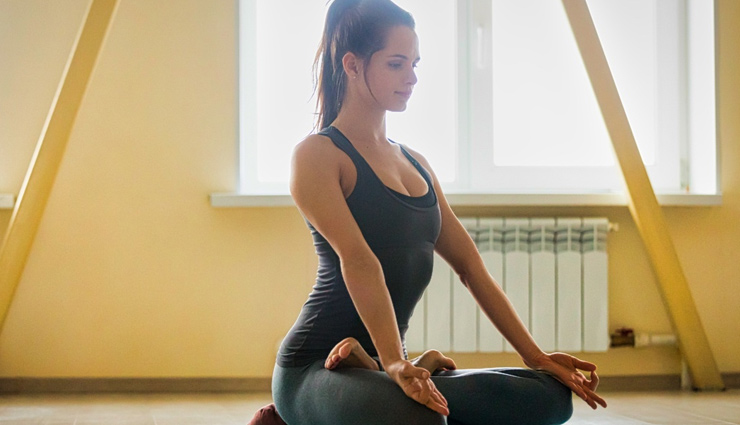
What Is Pranayama?
Pranayama is a yoga practice that emphasizes breath control and the respiratory system. For centuries, yogis have utilized Pranayama to enhance their health and calm their minds. It also plays a crucial role in improving skin appearance.
Pranayama involves coordinating your breath with your asanas, using breath control to facilitate the flow of life energy, or prana, throughout your body. It targets the respiratory system, boosts blood circulation, and purifies the blood, all of which contribute to better skin health and a luminous complexion.Pranayama for Glowing Skin

Kapalabhati, a form of shat kriya, aids in detoxifying your body. The term “Kapalabhati” combines Kapala, meaning forehead, and Bhati, meaning to shine. This technique involves passive inhalation and active exhalation, strengthening the lungs, enhancing circulation, and eliminating toxins. Regular practice of Kapalabhati can help clear your skin and impart a natural glow.
How to do Kapalabhati:
- Sit upright with your legs crossed and hands on your knees.
- Take a deep breath in through your nose and exhale through your mouth to cleanse and awaken your system.
- Inhale deeply, filling about ¾ of your belly with air.
- Exhale sharply through your nose, drawing your navel upwards.
- Inhale again, allowing your belly to fill up.
- Repeat this process ten times, then breathe normally.
- Complete this cycle ten times.
Who should refrain from Kapalabhati:
Avoid this practice if you have:
- Pregnancy
- Heart conditions
- Gastric issues
- Acid reflux
- Abdominal diseases
- High blood pressure
Bhastrika Pranayama, often called the “yogic breath of fire,” involves vigorous breathing that expels trapped air from the lungs. This technique energizes the body and calms the mind, enhancing oxygen levels in the blood and contributing to skin glow. Unlike Kapalabhati, Bhastrika focuses on forceful inhalation and exhalation.
How to do Bhastrika Pranayama:
- Sit upright with legs crossed.
- Take a deep breath, hold for five seconds, then release.
- Inhale forcefully, then exhale forcefully through your nose.
- Breathe in from your diaphragm.
- Keep your shoulders relaxed and your upper body still.
- Continue the forceful breathing for 30-45 seconds.
- Rest for a few seconds and repeat the cycle twice more.
Who should refrain from Bhastrika:
Avoid this practice if you have:
- Pregnancy
- Hypertension
- Seizures
- Panic disorders
- Heart issues
Pro tip: Bhastrika energizes your system, so it’s best not to practice it at night or on an empty stomach. Also, avoid it during a migraine.
Anulom Vilom, or alternate nostril breathing, controls pranic energy in the body. It stimulates the inner channels, clears respiratory blockages, and improves blood circulation. This practice helps detoxify the body and promotes mental tranquility, resulting in beautifully glowing skin.
How to do Anulom Vilom:
- Sit upright with legs crossed and your back straight.
- Take a deep breath, hold for a moment, and then release.
- Close your right nostril with your right thumb.
- Inhale deeply through the left nostril.
- Close your left nostril with your ring finger and exhale through your right nostril.
- Inhale through the right nostril, then close it and exhale through the left.
- Focus on matching your inhale and exhale times.
- Repeat for five minutes.
Pro tip: Gradually increase the inhale and exhale duration with regular practice, maintaining a consistent rhythm.
Nadi Shodan translates to cleansing of the subtle energy channels. This technique purifies blocked energy and respiratory pathways, ensuring healthy blood flow. It involves gentle breathing to open channels and enrich your bloodstream with oxygen, eliminating toxins for radiant skin.
How to do Nadi Shodan Pranayama:
- Sit upright and relax.
- Take a few deep breaths and center your focus.
- Lift your right hand, placing the index and middle fingers between your eyebrows.
- Close your right nostril with your right thumb.
- Take a gentle breath through the left nostril.
- Close the left nostril with your ring finger and exhale through the right.
- Inhale through the right nostril, then close it and exhale through the left.
- Repeat this cycle 20 times, completing it three times.
These three techniques are best practiced in sequence. Bhramari, or Bee Breath, calms the mind and relieves stress, hypertension, and depression. Udgeeth and Pranav further enhance the effects of Bhramari and soothe the nervous system, contributing to a radiant complexion.
How to do Bhramari, Udgeeth, and Pranav Pranayama:
- Sit upright with crossed knees and relax.
- Close your ears with your thumbs.
- Place your index fingers horizontally on your forehead and the other fingers over your eyes. Keep your mouth closed.
- Take a deep breath and chant a long “Aum” while exhaling through your nostrils, mimicking a bee's buzz.
- For Udgeeth, place your hands on your knees and straighten your posture.
- Take a deep breath in and out, focusing on the space between your eyebrows.
- Repeat the process of Bhramari and Udgeeth five times.
- Transition to Pranav Pranayama by keeping your hands on your knees, concentrating on the center of your eyebrows, and observing silence. Breathe deeply and gently for a more fulfilling experience.